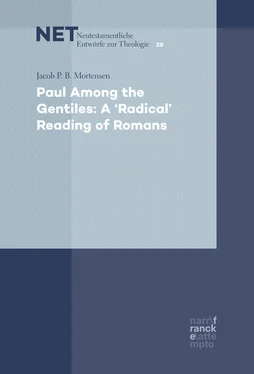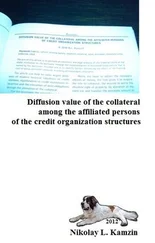For many years, the core of the text was thought to be 3:21–26, with its message of justification by faith, for all humanity, Jews and Gentiles alike. Also, many scholars focused on chapters 1 to 8, and perceived these chapters as concerned with justification (1–4) and sanctification (5–8). However, especially beginning with the work initiated by Johannes Munck (1904–1965) and Krister Stendahl (1921–2008), there followed a concern with the incorporation of chapters 9 to 11 into the overall understanding of Romans. With the advent of the ‘New Perspective’ on Paul – in the wake of scholars such as E.P. Sanders (* 1937), James Dunn (* 1939), Gerd Theissen (* 1943), Hans Dieter Betz (* 1931) and Heikki Räisänen (* 1941) – attention was broadened to the paraenetic part of the letter (chapters 12–15). The latest development in the interpretation of the letter comes from the ‘Radical New Perspective’ on Paul or ‘Paul within Judaism’, and includes scholars such as John Gager (* 1937), Mark D. Nanos (* 1954), Paula Fredriksen (* 1951), Magnus Zetterholm (*1958), Caroline Johnson Hodge, and Pamela Eisenbaum. Despite the fact that this group of scholars disagrees on several specific issues concerning the letter, they agree on Paul’s position as being ‘within Judaism’, and on his focus being exclusively on Gentiles.
In 1977 (and again in 1991), Karl P. Donfried edited a collection of essays under the title of The Romans Debate . This collection of essays proved to be seminal, because it gathered the most important contributions by some of the most influential scholars concerning the background, situation, and purpose of Romans. The scholars represented by the collection of essays provide various interpretations of the situation in the Roman assembly, and the purpose and meaning of the letter. Despite the differences in opinion about almost everything related to the letter, a consensus still seemed to grow from the first to the second edition of the book. In the introduction to the second edition, Karl Donfried explained the kind of consensus, from this point of view, that had been reached: Romans was addressed to the Christian community in Rome, and this community found itself in a particular historical situation, which influenced the perception of the letter.1 However, another and more important question also emerged from the discussion: How did the various parts of the letter contribute to the perception of the situation behind the letter, and the overall purpose of the letter – in short: What was the meaning of Romans, when all the parts were taken into account?
Scholars have struggled to answer the foregoing questions ever since, and there are often as many answers as there are scholars. Frequently, scholars work more concentratedly on the parts of the letter that they find most interesting, and touch on the question of the letter’s overall meaning and coherence only in passing. This approach may seem more manageable, since Romans has many profound and difficult passages. Nevertheless, in this monograph I wish to present my own interpretation of the entire letter. I suggest solutions to various problems that have emerged from readings by proponents of both the new and the radical new perspectives on Paul. As will become clear, my interpretation is inspired from the radical new perspective on Paul, but I do not consider my views to be part of the radical new perspective, as such.
I take a rather simple premise as my starting point: As should most ancient letters and books, Paul’s letter should be read from beginning to end. This assumption may seem self-evident, but it certainly is not. Several scholars have suggested reading Romans either from behind or from some hidden inner logic. If, as I propose here, we read Romans from beginning to end, we must be able to explain and evaluate the significance of every part of the letter to the progression and development of the discourse, and for its contribution to the meaning and purpose of the entire letter. Hence, the various parts build up to a climactic ending in the body of the letter. In this book, I argue that such a consecutive, successive, or straightforward reading of Romans – indeed, a coherent reading – is not only sensible and consistent with Paul’s situation, but also provides a logical, scholarly approach.
I argue that the first of the main parts of the letter (chapters 2–11) is the staging of a conversation between two persons, Paul and an interlocutor. If the introduction and staging of the interlocutor are to be perceived as parts of an ongoing dialogue, the epistolary persona should be relevant to the purpose of the letter. Hence, the two persons conversing must discuss something relevant to a) the interlocutor b) the group the person represents among the addressees and c) the purpose of the letter. Thus, the dialogue represents the historical situation in which it seeks to intervene, and it has indispensable value in terms of the purpose of the letter. From such a reading it follows that the final part of the letter should be seen as the natural and logical climax of the discourse and, hence, the most significant part for determining its purpose. Such a reading contrasts with interpretations of Romans that take 3:21–26 as the heart of the letter, and give less weight to the following 13 chapters.
As a minor qualification to the above-stated approach, it may not be necessary to look for a single purpose of the letter. Scholars have not been slow to realize that Paul presents himself more comprehensively in Romans than in his other letters. This has to do with the fact that he is addressing an assembly that he had not founded himself, and that was largely unknown to him personally (cf. Rom 15:20). Therefore, Paul’s self-presentation is considered one purpose of the letter. However, the specific and topical material in the final part of the letter, directed to the addressees in Rome, suggests that this could be the main purpose of the letter. With such an understanding of Romans, Paul may have wanted to intervene in Roman affairs, while introducing himself as apostle to the Gentiles, even if he had not founded the assembly himself. This would make Romans a real letter, which intervenes in an actual historical situation with an actual historical purpose, instead of being conceived as a theological will or tractate.
Despite the numerous suggested purposes of Romans, considering the various parts as contributing elements of a logical whole, and as equally important to the development of the argument or rhetorical strategy of the text, is crucial to an understanding of this letter. Therefore, I emphasize the overall purpose of the letter as defining the meaning of the letter. Hence, the preceding parts of the letter must be understood in such a way that they support the conclusion. One of the main questions that must be answered to reach this understanding concerns the identity of the interlocutor from chapter 2 onwards, and his relation to the circumstances behind the letter. With regard to these points, I combine two approaches: First, I rigorously address the text-internal information Paul provides about the interlocutor, the addressees, and Paul’s self-perception as apostle to the Gentiles. I will address these matters, first, in the introductory chapters on author and addressees, and also in the chapter on προσωποποιία. Secondly, I try to calibrate the text-internal findings to the general outlook of the radical new perspective’s emphasis on Gentiles as the exclusive objects of Paul’s missionary endeavour. What follows from this is that the conflict between the ‘strong’ and the ‘weak’ in the Roman assembly must be read against the background of a conflict between two Gentile groups. I intend to demonstrate that this is indeed how we should understand the situation described by Paul. Hence, I provide a reading of Romans from a general outlook (inspired by the radical new perspective) on Paul’s missionary activity as exclusively directed towards Gentiles, and combine this with the text-internal information of the letter concerning the interlocutor, addressees, and author.
Читать дальше












